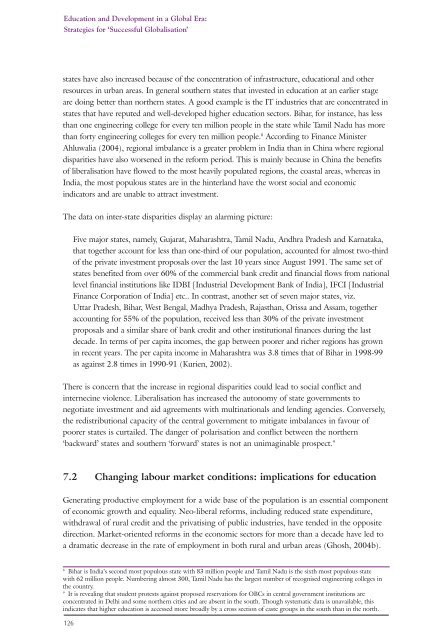education-dev-global-era-69
education-dev-global-era-69
education-dev-global-era-69
Create successful ePaper yourself
Turn your PDF publications into a flip-book with our unique Google optimized e-Paper software.
Education and Development in a Global Era:Strategies for ‘Successful Globalisation’states have also increased because of the concentration of infrastructure, <strong>education</strong>al and otherresources in urban areas. In gen<strong>era</strong>l southern states that invested in <strong>education</strong> at an earlier stageare doing better than northern states. A good example is the IT industries that are concentrated instates that have reputed and well-<strong>dev</strong>eloped higher <strong>education</strong> sectors. Bihar, for instance, has lessthan one engineering college for every ten million people in the state while Tamil Nadu has morethan forty engineering colleges for every ten million people. 8 According to Finance MinisterAhluwalia (2004), regional imbalance is a greater problem in India than in China where regionaldisparities have also worsened in the reform period. This is mainly because in China the benefitsof lib<strong>era</strong>lisation have flowed to the most heavily populated regions, the coastal areas, whereas inIndia, the most populous states are in the hinterland have the worst social and economicindicators and are unable to attract investment.The data on inter-state disparities display an alarming picture:Five major states, namely, Gujarat, Maharashtra, Tamil Nadu, Andhra Pradesh and Karnataka,that together account for less than one-third of our population, accounted for almost two-thirdof the private investment proposals over the last 10 years since August 1991. The same set ofstates benefited from over 60% of the commercial bank credit and financial flows from nationallevel financial institutions like IDBI [Industrial Development Bank of India], IFCI [IndustrialFinance Corporation of India] etc.. In contrast, another set of seven major states, viz.Uttar Pradesh, Bihar, West Bengal, Madhya Pradesh, Rajasthan, Orissa and Assam, togeth<strong>era</strong>ccounting for 55% of the population, received less than 30% of the private investmentproposals and a similar share of bank credit and other institutional finances during the lastdecade. In terms of per capita incomes, the gap between poorer and richer regions has grownin recent years. The per capita income in Maharashtra was 3.8 times that of Bihar in 1998-99as against 2.8 times in 1990-91 (Kurien, 2002).There is concern that the increase in regional disparities could lead to social conflict andinternecine violence. Lib<strong>era</strong>lisation has increased the autonomy of state governments tonegotiate investment and aid agreements with multinationals and lending agencies. Conversely,the redistributional capacity of the central government to mitigate imbalances in favour ofpoorer states is curtailed. The danger of polarisation and conflict between the northern‘backward’ states and southern ‘forward’ states is not an unimaginable prospect. 97.2 Changing labour market conditions: implications for <strong>education</strong>Gen<strong>era</strong>ting productive employment for a wide base of the population is an essential componentof economic growth and equality. Neo-lib<strong>era</strong>l reforms, including reduced state expenditure,withdrawal of rural credit and the privatising of public industries, have tended in the oppositedirection. Market-oriented reforms in the economic sectors for more than a decade have led toa dramatic decrease in the rate of employment in both rural and urban areas (Ghosh, 2004b).8Bihar is India’s second most populous state with 83 million people and Tamil Nadu is the sixth most populous statewith 62 million people. Numbering almost 300, Tamil Nadu has the largest number of recognised engineering colleges inthe country.9It is revealing that student protests against proposed reservations for OBCs in central government institutions areconcentrated in Delhi and some northern cities and are absent in the south. Though systematic data is unavailable, thisindicates that higher <strong>education</strong> is accessed more broadly by a cross section of caste groups in the south than in the north.126





